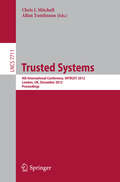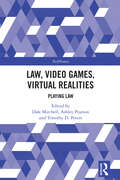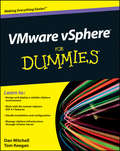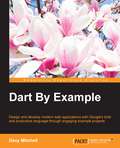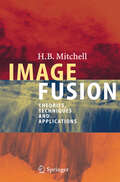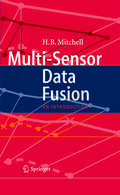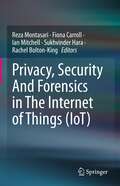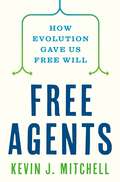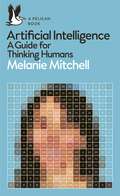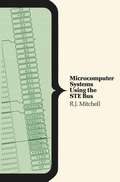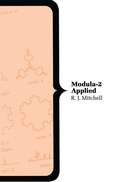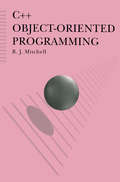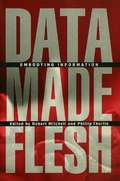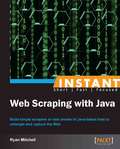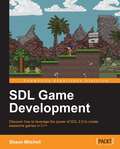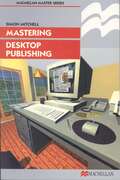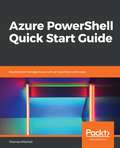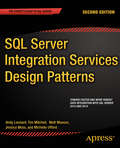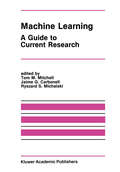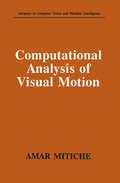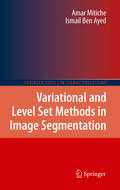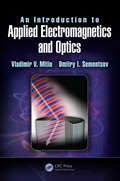- Table View
- List View
Trusted Systems: 4th International Conference, INTRUST 2012, London, UK, December 17-18, 2012, Proceedings (Lecture Notes in Computer Science #7711)
by Chris J. Mitchell Allan TomlinsonThis book constitutes the refereed proceedings of the International Conference on Trusted Systems, INTRUST 2012, held in London, UK, in December 2012. The 6 revised full papers presented together with 3 short invited papers and a short paper which formed the basis for a panel session were carefully reviewed and selected from 19 submissions. The papers are organized in topical section on automated analysis, security and trust, mobile trust, security of distributed systems, evaluation and analysis, and embedded security.
Law, Video Games, Virtual Realities: Playing Law (TechNomos)
by Dale Mitchell Ashley Pearson Timothy D. PetersThis edited volume explores the intersection between the coded realm of the video game and the equally codified space of law through an insightful collection of critical readings. Law is the ultimate multiplayer role-playing game. Involving a process of world-creation, law presents and codifies the parameters of licit and permitted behaviour, requiring individuals to engage their roles as a legal subject – the player-avatar of law – in order to be recognised, perform legal actions, activate rights or fulfil legal duties. Although traditional forms of law (copyright, property, privacy, freedom of expression) externally regulate the permissible content, form, dissemination, rights and behaviours of game designers, publishers, and players, this collection examines how players simulate, relate, and engage with environments and experiences shaped by legality in the realm of video game space. Featuring critical readings of video games as a means of understanding law and justice, this book contributes to the developing field of cultural legal studies, but will also be of interest to other legal theorists, socio-legal scholars, and games theorists.
VMware vSphere For Dummies
by Daniel Mitchell Tom KeeganA plain-English guide to the market-leading virtualization and cloud computing technology With virtualization, a single server can host dozens or hundreds of virtual machines running a variety of operating systems, and even hook them together in a virtual network or cloud infrastructure. This practical guide shows you how to create a virtual system using the VMware VSphere environment. You'll find all the information you need to understand, design, and deploy one—without getting overwhelmed with technical detail. And once you’re up and running, this book is the perfect reference for maintenance and troubleshooting issues. Introduces you to virtualization and VMware’s virtualization/cloud computing technology, the most recent version is VMware vSphere Shows you how to design a vSphere environment Covers installation, deployment, management, maintenance, and troubleshooting Provides what IT managers and system administrators need to roll out their first virtualized or cloud infrastructure, or to get up to speed on VMware’s technology Get up and running on the cloud with VMware vSphere For Dummies!
VMware vSphere For Dummies
by Daniel Mitchell Tom KeeganA plain-English guide to the market-leading virtualization and cloud computing technology With virtualization, a single server can host dozens or hundreds of virtual machines running a variety of operating systems, and even hook them together in a virtual network or cloud infrastructure. This practical guide shows you how to create a virtual system using the VMware VSphere environment. You'll find all the information you need to understand, design, and deploy one—without getting overwhelmed with technical detail. And once you’re up and running, this book is the perfect reference for maintenance and troubleshooting issues. Introduces you to virtualization and VMware’s virtualization/cloud computing technology, the most recent version is VMware vSphere Shows you how to design a vSphere environment Covers installation, deployment, management, maintenance, and troubleshooting Provides what IT managers and system administrators need to roll out their first virtualized or cloud infrastructure, or to get up to speed on VMware’s technology Get up and running on the cloud with VMware vSphere For Dummies!
Dart By Example
by Davy MitchellDesign and develop modern web applications with Google's bold and productive language through engaging example projects About This Book • Full of engaging and varied example projects to equip you to build your own web applications • Learn the Dart language and key libraries • Productively create fast and reliable web applications Who This Book Is For If you are a front- or back-end web developer who is looking to build complex full-featured web applications without the quagmire of disconnected JavaScript frameworks, this book is a practical walkthrough of substantial applications that will have you and your team coding Dart in a productive manner. This book will give you a compiled, optional typed, scalable environment to rapidly develop applications. As Dart was designed to be familiar, any developer with even a small amount of knowledge of JavaScript or another programming language will be at home with the language immediately and will be coding quickly. What You Will Learn • Master the core Dart language, type system, and key development tools • Connect to existing web services, process JSON, and create your own framework for the data display • Run and debug the Dart server and web applications and compile them in JavaScript • Handle form data and encryption • Build and deploy server applications on the major OSes and implement the REST API • Work with PostgreSQL—an industry standard relational database system • Create robust applications with unit tests, documentation, and diagnostic logging • Develop command-line applications, and explore the key data structures and libraries In Detail Designed to create next generation apps, Google's Dart offers a much more robust framework and also supersedes JavaScript in several aspects. Familiar yet innovative, compact yet scalable, it blows away the accumulated JavaScript legacy limitations. Dart was designed for great tool-ability and developer productivity, allowing you to create better application faster than before. Google chose it for their billion dollar advertising business and you have its power for your projects too. This book will introduce you the Dart language starting from its conception to its current form, and where it headed is through engaging substantial practical projects. You will be taken through building typical applications and exploring the exciting new technologies of HTML5. With example code projects such as a live data monitoring and viewing system, a blogging system, a slides presentation application, and more, then this book will walk you through step by step through building data-driven web applications with ease and speed. Style and approach A varied collection of compelling practical Dart projects that are developed progressively with full explanations of concepts and implementation. Each project introduces features of the language and environment, demonstrating how Dart can be used in rich structured web applications.
Image Fusion: Theories, Techniques and Applications
by H.B. MitchellThe purpose of this book is to provide a practical introduction to the th- ries, techniques and applications of image fusion. The present work has been designed as a textbook for a one-semester ?nal-year undergraduate, or ?r- year graduate, course in image fusion. It should also be useful to practising engineers who wish to learn the concepts of image fusion and apply them to practical applications. In addition, the book may also be used as a supp- mentary text for a graduate course on topics in advanced image processing. The book complements the author’s previous work on multi-sensor data [1] fusion by concentrating exclusively on the theories, techniques and app- cations of image fusion. The book is intended to be self-contained in so far as the subject of image fusion is concerned, although some prior exposure to the ?eld of computer vision and image processing may be helpful to the reader. Apart from two preliminary chapters, the book is divided into three parts.
Multi-Sensor Data Fusion: An Introduction
by H.B. MitchellThis textbook provides a comprehensive introduction to the theories and techniques of multi-sensor data fusion. It is aimed at advanced undergraduate and first-year graduate students in electrical engineering and computer science, as well as researchers and professional engineers. The book is intended to be self-contained. No previous knowledge of multi-sensor data fusion is assumed, although some familiarity with the basic tools of linear algebra, calculus and simple probability theory is recommended.
Privacy, Security And Forensics in The Internet of Things (IoT)
by Ian Mitchell Reza Montasari Fiona Carroll Sukhvinder Hara Rachel Bolton-KingThis book provides the most recent security, privacy, technical and legal challenges in the IoT environments. This book offers a wide range of theoretical and technical solutions to address these challenges. Topics covered in this book include; IoT, privacy, ethics and security, the use of machine learning algorithms in classifying malicious websites, investigation of cases involving cryptocurrency, the challenges police and law enforcement face in policing cyberspace, the use of the IoT in modern terrorism and violent extremism, the challenges of the IoT in view of industrial control systems, and the impact of social media platforms on radicalisation to terrorism and violent extremism.This book also focuses on the ethical design of the IoT and the large volumes of data being collected and processed in an attempt to understand individuals’ perceptions of data and trust. A particular emphasis is placed on data ownership and perceived rights online. It examines cyber security challenges associated with the IoT, by making use of Industrial Control Systems, using an example with practical real-time considerations. Furthermore, this book compares and analyses different machine learning techniques, i.e., Gaussian Process Classification, Decision Tree Classification, and Support Vector Classification, based on their ability to learn and detect the attributes of malicious web applications. The data is subjected to multiple steps of pre-processing including; data formatting, missing value replacement, scaling and principal component analysis. This book has a multidisciplinary approach. Researchers working within security, privacy, technical and legal challenges in the IoT environments and advanced-level students majoring in computer science will find this book useful as a reference. Professionals working within this related field will also want to purchase this book.
Free Agents: How Evolution Gave Us Free Will
by Kevin J. MitchellAn evolutionary case for the existence of free willScientists are learning more and more about how brain activity controls behavior and how neural circuits weigh alternatives and initiate actions. As we probe ever deeper into the mechanics of decision making, many conclude that agency—or free will—is an illusion. In Free Agents, leading neuroscientist Kevin Mitchell presents a wealth of evidence to the contrary, arguing that we are not mere machines responding to physical forces but agents acting with purpose.Traversing billions of years of evolution, Mitchell tells the remarkable story of how living beings capable of choice arose from lifeless matter. He explains how the emergence of nervous systems provided a means to learn about the world, granting sentient animals the capacity to model, predict, and simulate. Mitchell reveals how these faculties reached their peak in humans with our abilities to imagine and to be introspective, to reason in the moment, and to shape our possible futures through the exercise of our individual agency. Mitchell’s argument has important implications—for how we understand decision making, for how our individual agency can be enhanced or infringed, for how we think about collective agency in the face of global crises, and for how we consider the limitations and future of artificial intelligence.An astonishing journey of discovery, Free Agents offers a new framework for understanding how, across a billion years of Earth history, life evolved the power to choose, and why it matters.
Free Agents: How Evolution Gave Us Free Will
by Kevin J. MitchellAn evolutionary case for the existence of free willScientists are learning more and more about how brain activity controls behavior and how neural circuits weigh alternatives and initiate actions. As we probe ever deeper into the mechanics of decision making, many conclude that agency—or free will—is an illusion. In Free Agents, leading neuroscientist Kevin Mitchell presents a wealth of evidence to the contrary, arguing that we are not mere machines responding to physical forces but agents acting with purpose.Traversing billions of years of evolution, Mitchell tells the remarkable story of how living beings capable of choice arose from lifeless matter. He explains how the emergence of nervous systems provided a means to learn about the world, granting sentient animals the capacity to model, predict, and simulate. Mitchell reveals how these faculties reached their peak in humans with our abilities to imagine and to be introspective, to reason in the moment, and to shape our possible futures through the exercise of our individual agency. Mitchell’s argument has important implications—for how we understand decision making, for how our individual agency can be enhanced or infringed, for how we think about collective agency in the face of global crises, and for how we consider the limitations and future of artificial intelligence.An astonishing journey of discovery, Free Agents offers a new framework for understanding how, across a billion years of Earth history, life evolved the power to choose, and why it matters.
Artificial Intelligence: A Guide for Thinking Humans (Pelican Books)
by Melanie MitchellNo recent scientific enterprise has been so alluring, terrifying, and filled with extravagant promise and frustrating setbacks as artificial intelligence. How intelligent are the best of today's AI programs? To what extent can we entrust them with decisions that affect our lives? How human-like do we expect them to become, and how soon do we need to worry about them surpassing us in most, if not all, human endeavours? From leading AI researcher and award-winning author Melanie Mitchell comes a knowledgeable and captivating account of modern-day artificial intelligence. Flavoured with personal stories and a twist of humor, Artificial Intelligence illuminates the workings of machines that mimic human learning, perception, language, creativity and common sense. Weaving together advances in AI with cognitive science and philosophy, Mitchell probes the extent to which today's 'smart' machines can actually think or understand, and whether AI requires such elusive human qualities in order to be reliable, trustworthy and beneficial. Artificial Intelligence: A Guide for Thinking Humans provides readers with an accessible, entertaining, and clear-eyed view of the AI landscape, what the field has actually accomplished, how much further it has to go, and what it means for all of our futures.
Microcomputer Systems Using the STE Bus (Computer Science Series)
by R J MitchellThe IEEE approved STE bus is the newest bus standard to be introduced to ensure efficient and reliable communication between microprocessors and related devices. After introducing bus systems, the author gives a survey of buses. This is followed by detailed interfacing of slave devices to STE, with practical circuits. Other typical slave devices are then discussed. The various ways in which one or many microprocessors and other bus masters may be connected to STE are described. Testing, software, practical aspects of digital circuitry and technical requirements of the STE specification are then considered. Finally, algorithms for the design of sequential logic circuits are presented.
Modula-2 Applied (Computer Science Series)
by R J MitchellProgramming is a skill requiring knowledge of both the basic constructs of computer languages and the techniques employing these constructs. How these are used in any application is often determined by experience of existing programs. This book provides such experience by describing the techniques and implementing them in one useful program: an advanced drawing package. The book also shows the development of a large program. The program is implemented using TopSpeed Modula-2 running on IBM PCs and compatibles. Modula-2 is ideally suited for the task. A knowledge of the language is assumed. The program, including its source, is available on disk.
C++ Object-Oriented Programming (Computer Science Series)
by R.J. MitchellDescribes object-oriented techniques and shows how they can be used in the development of a reasonably larger program which is implemented in C++. Choosing the practical example of a computer-based drawing package, the author describes how the package is designed using an object-oriented approach and then written and implemented in C++. The program is written in Turbo C++ and therefore can be used on IBM PCs or compatibles. Assumes some knowledge of a high level language, such as C, Pascal, Modula-2 or Ada.
Data Made Flesh: Embodying Information
by Robert Mitchell Phillip ThurtleIn an age of cloning, cyborgs, and biotechnology, the line between bodies and bytes seems to be disappearing. Data Made Flesh is the first collection to address the increasingly important links between information and embodiment, at a moment when we are routinely tempted, in the words of Donna Haraway, "to be raptured out of the bodies that matter in the lust for information," whether in the rush to complete the Human Genome Project or in the race to clone a human being.
Data Made Flesh: Embodying Information
by Robert Mitchell Phillip ThurtleIn an age of cloning, cyborgs, and biotechnology, the line between bodies and bytes seems to be disappearing. Data Made Flesh is the first collection to address the increasingly important links between information and embodiment, at a moment when we are routinely tempted, in the words of Donna Haraway, "to be raptured out of the bodies that matter in the lust for information," whether in the rush to complete the Human Genome Project or in the race to clone a human being.
Instant Web Scraping with Java
by Ryan MitchellFilled with practical, step-by-step instructions and clear explanations for the most important and useful tasks. This book is full of short, concise recipes to learn a variety of useful web scraping techniques using Java. You will start with a simple basic recipe of setting up your Java environment and gradually learn some more advanced recipes such as using complex Scrapers. Instant Web Scraping with Java is aimed at developers who, while not necessarily familiar with Java, are at least ready to dive into the complexities of this language with simple, step-by-step instructions leading the way. It is assumed that you have at least an intermediate knowledge of HTML, some knowledge of MySQL, and access to an Internet-connected computer while doing most of the exercises (after all, scraping the Web is difficult if your code can't get online!)
SDL Game Development
by Shaun Ross MitchellWritten as a practical and engaging tutorial, SDL Game Development guides you through developing your own framework and the creation of two engaging games.If you know C++ and you're looking to make great games from the ground up, then this book is perfect for you.
Mastering Desktop Publishing (Macmillan Master Series)
by Simon MitchellIf you design to publish on a computer, in print or digital media, then this book is an essential resource. Both the quality and effectiveness of your work will improve through focus on design.This easy-to-follow book describes processes and tools available for successful desktop publishing (DTP), backed up with over two hundred illustrations. It reveals the tricks, secrets and magic ingredients for design in desktop publishing.Recommended for `in-house' DTP and those studying:· communications· media · business · marketing· design · desktop publishingMastering Desktop Publishing offers the reader techniques, skills and strategies to achieve effective results in publishing.
Azure PowerShell Quick Start Guide: Deploy And Manage Azure Virtual Machines With Ease
by Thomas MitchellAs an IT professional, it is important to keep up with cloud technologies and learn to manage those technologies. PowerShell is a critical tool that must be learned in order to effectively and more easily manage many Azure resources. This book is designed to teach you to leverage PowerShell to perform many day-to-day tasks in Microsoft Azure.
SQL Server Integration Services Design Patterns
by Tim Mitchell Matt Masson Andy Leonard Jessica Moss Michelle UffordSQL Server Integration Services Design Patterns is newly-revised for SQL Server 2014, and is a book of recipes for SQL Server Integration Services (SSIS). Design patterns in the book help to solve common problems encountered when developing data integration solutions. The patterns and solution examples in the book increase your efficiency as an SSIS developer, because you do not have to design and code from scratch with each new problem you face. The book's team of expert authors take you through numerous design patterns that you'll soon be using every day, providing the thought process and technical details needed to support their solutions. SQL Server Integration Services Design Patterns goes beyond the surface of the immediate problems to be solved, delving into why particular problems should be solved in certain ways. You'll learn more about SSIS as a result, and you'll learn by practical example. Where appropriate, the book provides examples of alternative patterns and discusses when and where they should be used. Highlights of the book include sections on ETL Instrumentation, SSIS Frameworks, Business Intelligence Markup Language, and Dependency Services.Takes you through solutions to common data integration challengesProvides examples involving Business Intelligence Markup LanguageTeaches SSIS using practical examples
Machine Learning: A Guide to Current Research (The Springer International Series in Engineering and Computer Science #12)
by Tom M. Mitchell Jaime G. Carbonell Ryszard S. MichalskiOne of the currently most active research areas within Artificial Intelligence is the field of Machine Learning. which involves the study and development of computational models of learning processes. A major goal of research in this field is to build computers capable of improving their performance with practice and of acquiring knowledge on their own. The intent of this book is to provide a snapshot of this field through a broad. representative set of easily assimilated short papers. As such. this book is intended to complement the two volumes of Machine Learning: An Artificial Intelligence Approach (Morgan-Kaufman Publishers). which provide a smaller number of in-depth research papers. Each of the 77 papers in the present book summarizes a current research effort. and provides references to longer expositions appearing elsewhere. These papers cover a broad range of topics. including research on analogy. conceptual clustering. explanation-based generalization. incremental learning. inductive inference. learning apprentice systems. machine discovery. theoretical models of learning. and applications of machine learning methods. A subject index IS provided to assist in locating research related to specific topics. The majority of these papers were collected from the participants at the Third International Machine Learning Workshop. held June 24-26. 1985 at Skytop Lodge. Skytop. Pennsylvania. While the list of research projects covered is not exhaustive. we believe that it provides a representative sampling of the best ongoing work in the field. and a unique perspective on where the field is and where it is headed.
Computational Analysis of Visual Motion (Advances in Computer Vision and Machine Intelligence)
by Amar MiticheImage motion processing is important to machine vision systems because it can lead to the recovery of 3D structure and motion. Author Amar Mitiche offers a comprehensive mathematical treatment of this key subject in visual systems research. Mitiche examines the interpretation of point correspondences as well as the interpretation of straight line correspondences and optical flow. In addition, the author considers interpretation by knowledge-based systems and presents the relevant mathematical basis for 3D interpretation.
Variational and Level Set Methods in Image Segmentation (Springer Topics in Signal Processing #5)
by Amar Mitiche Ismail Ben AyedImage segmentation consists of dividing an image domain into disjoint regions according to a characterization of the image within or in-between the regions. Therefore, segmenting an image is to divide its domain into relevant components. The efficient solution of the key problems in image segmentation promises to enable a rich array of useful applications. The current major application areas include robotics, medical image analysis, remote sensing, scene understanding, and image database retrieval. The subject of this book is image segmentation by variational methods with a focus on formulations which use closed regular plane curves to define the segmentation regions and on a level set implementation of the corresponding active curve evolution algorithms. Each method is developed from an objective functional which embeds constraints on both the image domain partition of the segmentation and the image data within or in-between the partition regions. The necessary conditions to optimize the objective functional are then derived and solved numerically. The book covers, within the active curve and level set formalism, the basic two-region segmentation methods, multiregion extensions, region merging, image modeling, and motion based segmentation. To treat various important classes of images, modeling investigates several parametric distributions such as the Gaussian, Gamma, Weibull, and Wishart. It also investigates non-parametric models. In motion segmentation, both optical flow and the movement of real three-dimensional objects are studied.
An Introduction to Applied Electromagnetics and Optics
by Vladimir V. Mitin Dmitry I. SementsovModern technology is rapidly developing and for this reason future engineers need to acquire advanced knowledge in science and technology, including electromagnetic phenomena. This book is a contemporary text of a one-semester course for junior electrical engineering students. It covers a broad spectrum of electromagnetic phenomena such as, surface waves, plasmas, photonic crystals, negative refraction as well as related materials including superconductors. In addition, the text brings together electromagnetism and optics as the majority of texts discuss electromagnetism disconnected from optics. In contrast, in this book both are discussed. Seven labs have been developed to accompany the material of the book.
